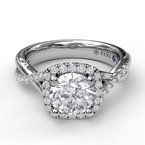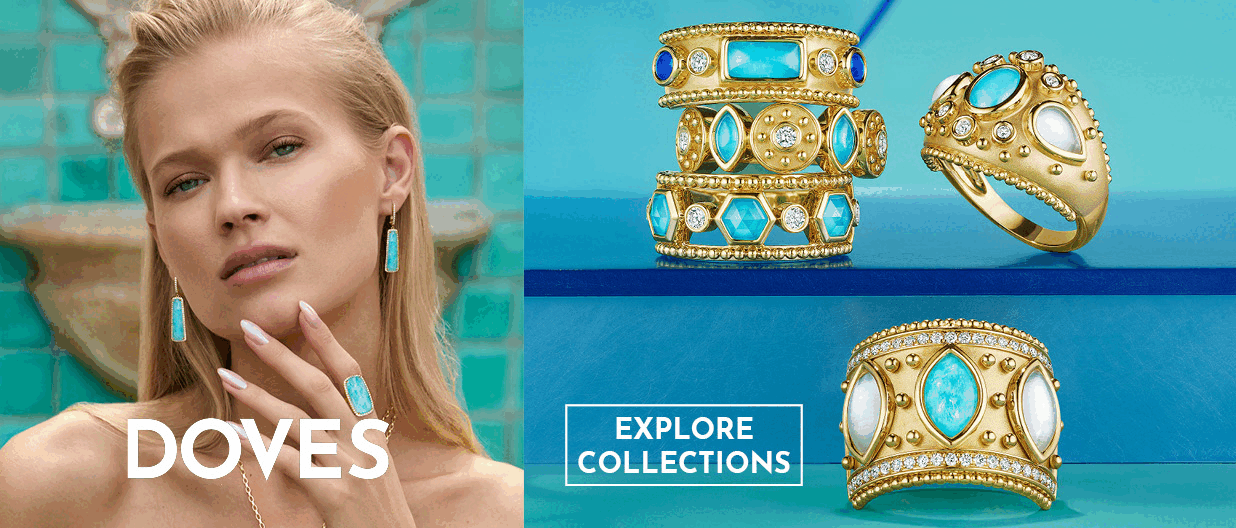Sales Strategy
The Knot’s Annual Jewelry Survey: Average DER $6,800, But 34% Of Respondents OK With Lab-Grown Stone | December 08, 2021 (0 comments)

New York, NY—The Knot, a leading all-in-one wedding-planning resource, has released its 2021 Jewelry & Engagement Study, revealing top trends in engagement and wedding jewelry purchases. The Knot’s annual survey has become a critical benchmark for better jewelers, as its findings about engagement jewelry spending is more reflective of better jewelers’ more affluent customer base. The study polled 5,017 U.S. couples age 18-54 who got engaged between January 1 and November 7, 2021. Image: a cushion halo engagement ring from Fana.
While diamonds are still the first choice for an engagement ring, a surprising number of couples (34%) say it’s not essential that the ring feature a natural mined stone. Nearly one in four engagement rings in 2021 featured a center stone that was man-made, up 11% in the past two years, says The Knot study. Gen Z (ages 18-24) is least concerned about a natural stone—only 28% of those consumers said it was important to have a natural stone—compared to 35% of Millennials and 41% of Gen-X who say it’s important to have a natural stone in their engagement ring.
What’s especially important to note, however, is that the study’s phrasing positioned the question as one of eco-consciousness, and respondents answered in that vein. This suggests that whether accurate or not, the lab-grown sector has indeed taken ownership of ecology narrative, and the natural diamond sector’s efforts to counter it have not been very successful so far.
Key engagement shopping trends. Jewelers will be happy to know that shoppers still favor in-store ring purchasing. The Knot study found that while online channels, such as social media and jewelry websites, continue to be the leading resource for ring research and inspiration, proposers value the importance of in-store shopping. 67% of rings were purchased in-store, with half of in-store purchases in 2021 happening at local jewelers.
Proposers visited two to three retailers in-store, and checked out 10 rings on average before purchasing.
The average engagement ring spend (all rings) in 2021 was $6,000, edging up incrementally from 2019’s pre-pandemic spend of $5,900 reported by The Knot last year. Not surprisingly, Millennials (ages 25-34) spent more than their younger Gen Z counterparts (ages 18-24) for an engagement ring: Millennials spent $6,700 on average and Gen Z spent $4,100 on average. Ring costs vary by type of stone, with the average cost of a clear diamond engagement ring being the highest at $6,800, vs. an average of $2,500 for another gemstone.
It should be noted that The Knot's $6,000 average spend figure is significantly higher than the broader average of $3,790, calculated by industry analyst Edahn Golan earlier this year.
Of those shoppers that set a budget for the engagement ring, roughly two-thirds stuck to their budget, while nearly 30% spent more than planned, a 9% increase since 2020, says The Knot.
The most popular type of engagement stone continues to be diamonds (86%), with round (41%) remaining the most popular cut; however, ovals have seen a steady increase in popularity over the past six years, from 2% in 2015 to 19% in 2021.
Shape and setting continue to be the most important ring features, while size has become less important. Nevertheless, the average size of an engagement ring is not insignificant: 1.5 carats in total, with one in four engagement rings over 2.0 carats in total.
The popularity of white gold engagement rings has declined, with 61% of rings being white gold in 2017 to now less than half in 2021 (45%). Yellow gold engagement rings are once again gaining popularity, with an 11% increase since 2017.
Among the 10% of respondents who chose a non-diamond gemstone for their center stone, the most popular is moissanite, which now accounts for more than one-quarter of non-diamond stones (28%, +9% vs. 2019), and is even more popular among Gen Z (35%).
Other important proposal and wedding trends. The Knot found engagement planning timelines were back to pre-pandemic behavior, as most 2021 proposals were planned more than a month out, vs. 2020 when nearly 50% of proposals were planned within the month. Other key findings:
- 70% of couples date for two or more years before getting engaged.
- A huge increase in outdoor engagement proposals (73% in 2021, vs. 40% in 2020). 35% occurred at a scenic spot such as a mountain top or a place with a city view.
- Nearly one in three engagements took place during a planned trip, up 7% from last year when many trips were halted.
- With restrictions lifting throughout 2021, one in four proposers say they felt pressure to plan a unique proposal, back in-line with pre-pandemic numbers.
- 19% of proposers hired photographers and other vendors to help with the proposal (vs. 12% in 2019).
- 93% of couples exchanged a ring.
- Over 90% of couples announced their engagement on social media, with Instagram (78%) and Facebook (77%) being the most popular, and 20% of couples announced on Snapchat.
- Of those who got engaged in 2021, over 75% have already set a wedding date for 2022, with fall being the most popular season.
- Roughly 85% of couples started wedding planning within less than two months, with 60% planning within a month of getting engaged—and a whopping 90% talked about at least one aspect of wedding planning prior to getting engaged.
“We’re thrilled to see that proposals are returning to pre-pandemic behaviors. The majority of couples are already booking their weddings for 2022, as the wedding boom is upon us,” said Shelley Brown, Senior Fashion and Beauty Editor, The Knot. “With this renewed excitement surrounding proposals comes an increased interest in highly personalized engagement rings. Oval diamonds, yellow gold settings and alternative center stones like moissanite and sapphire are all gaining popularity, speaking to couples’ increasing desire to invest in wedding traditions that represent their specific love story and personal taste.”






